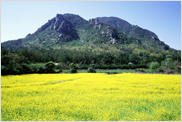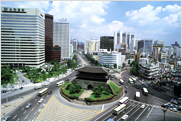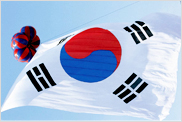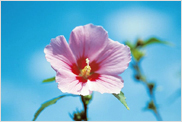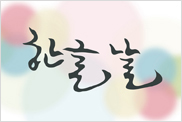About Korea

- About Korea
- Korea Introduce
Korea Introduce
Location
- East / 131'52'42"E, West / 124'11'00"E, South / 33'06'40"N, North / 43'00'39"N
- The Korean Peninsular extends southward from the northeast part of the Asian Continent between 33and 43 North Latitude and 124 and 132 East Longtitude. The standard meridian of the peninsular os 135, nine hours ahead of GMT. The Amnok and Tuman Rivers border both China and Russia to the north, and Japan is just across the East Sea.
- http://www.korea.go.kr (Republic of Korean government)
Area
- The total area of the peninsular is 221,154 km2, similar in size to that of United Kingdom. South Korea, possessing 99,237 km2 below the Demilitarized Zone, is a little larger than Hungary and smaller than Iceland.
Population
- Approximately 48,116,264 (2004 est.)
- http://www.nso.go.kr (Department of National Statistical Office)
Capital
- Seoul. It is located on the lower Hangang(Han River) crossing the waist of the Korean Peninsular. Over 25% of the population lives in Seoul and nearby cities. Seoul, with central organization of executive, legislative and judicial branch, is a political, economic and cultural center of Korea.
- http://www.metro.seoul.kr (city hall of Seoul)
The National Flag of Republic of Korea
- The Korean Flag is called Taegukki, standinfg for peace, unity, creation, light and eternity. The taeguk circle in the center of the flag symbolizes the principles of yin and yang, the origins from which the cosmic nature is created, in Oriental philosophy. It stands for the headspring of human life and immortality. The trigrams surrounding taeguk, denote the process of yin and yang going through a spiral of change and growth. The white background of the flag represents the homogenousness and purity of Korean people and their peace-loving spirit.
- The flag was used by Park Yong-Hyo for the first time, who was delegated to Japan in 1882. In 1883(20th year of the reign of King Kojong), the falg was officially declared as the national f flag.
- http://www.korea.go.kr (Republic of Korean government)
The National Anthem
- The National Anthem of Korea is Aegukka from the time of the establishment of Korean government in August, 1948. Composed of 16 bars, the anthem is concise and solemn.
The Nationl Flower
- Koreans speak a unique Korean language and write Hangul. Korean, a branch of Altaic , has a close relation to Southern Tungus. The languages in Korean peninsular were unified in the late 7th century when Shilla Kingdom unified the three nations. The standard language at the present is "language spoken in Seoul by the middle class" Hangul, a Korean alphabet, was invented by King Sejong in 1443. It consists of 10vowels and 14 consonants. It has been famous as a scientific alphabet with capacity of wide expression.
Climate
- Korea, Stretching out from 33 to 43 North Latitude, has a outstanding contrast of temperature between the north and south, and between the east and west. The climate can be characterized as continental monsoon. Korea enjoy a sharp distinction of four seasons with a little longer summer and winter than spring and autumn.
- http://www.kma.go.kr (Korea Meteorological Administration)

